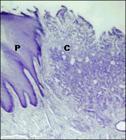ABSTRACT
Considering the importance of paca (Cuniculus paca, Linnaeus, 1766) as an alternative protein source for the population as well as the possibility to become an experimental model and the lack of information regarding to the anatomy of this species, the present study aims to describe the gross anatomy and the histology of the stomach and duodenum of this rodent, recognizing the relations, shape and position that these organs establish between themselves and among other organs. The paca stomach is monocavitary; it is located at the median plane, more toward the left antimere, transversally, at the hypochondriac region in a ventrocaudal position, interposed between the esophagus and duodenum. The duodenum of paca begins in sequence of the stomach, following caudally until the fifth or sixth lumbar vertebra, at this level it curves and takes the cranial direction, going until the transition level between the last thoracic vertebra and the first lumbar vertebra where it continues as jejune. Histologically, the stomach and duodenum of paca have the characteristic pattern of the hollow organs architecture, presenting the following layers: mucosa, submucosa, muscular and serous. As this study was conducted, it is possible to conclude that the stomach and duodenum of paca, in general, present gross anatomical and histological characteristics similar to the domestic animals and to the other wild rodents.
anatomy; rodent; wild

 Thumbnail
Thumbnail
 Thumbnail
Thumbnail
 Thumbnail
Thumbnail


